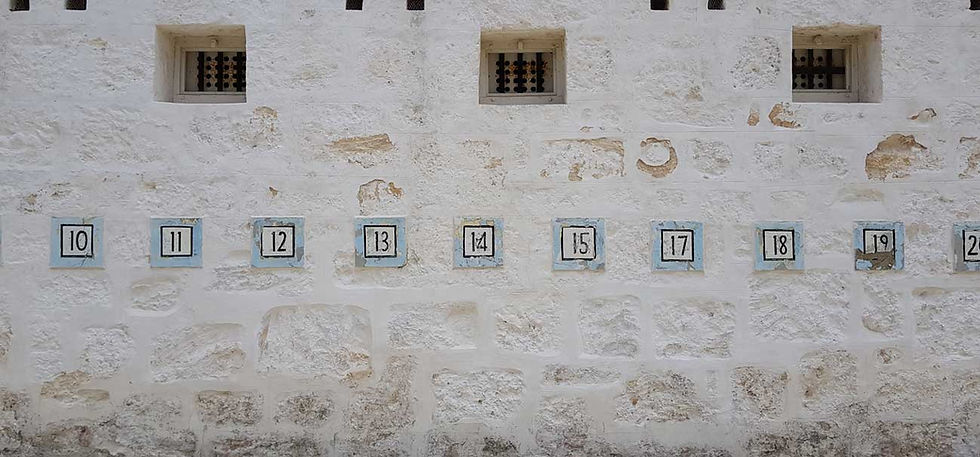
Exercise Yards

Significance
The Exercise Yards are a key historical convict-built component of Fremantle Prison, and more specifically of the Main Cell Block complex. They are functionally related to the Main Cell Block, and their walled divisions provide evidence of the classification and segregation of dif-ferent prisoner groups. They are also prominent elements of the Prison site through their large footprint. Evidence of the prisoners’ con-fine--ment in and use of the Exercise Yards, and their treatment of the Exercise Yards’ walls over time, including murals and graffiti, are powerful reminders of the prisoner experience. The gallows are also significant.
Those parts of the Exercise Yards that are of exceptional significance are as follows:
-
Exercise Yards (size, general form and layout) including all convict-built walls and elements
Those parts of the Exercise Yards that are of considerable significance are as follows:
-
post-convict era (colonial prison) yard divisions and associated walls
-
gallows
-
water closets, urinals and ablution troughs (on the diagonal to yard corners)
Those parts of the Exercise Yards that are of some significance are as follows:
-
historic murals and graffiti
-
all shelter sheds, tables and seating
-
later kitchen-related fabric and fit-out to southern yard
Those parts of the Exercise Yards that are of little or no significance are as follows:
-
yard surfaces, services, lighting etc
-
all other modern fabric
Principles
PRINCIPLE 33: The Exercise Yards should be conserved to the highest standards, consistent with Burra Charter principles and processes.
PRINCIPLE 34: Retain and conserve the Exercise Yards including their plan, form and layout, and the stone enclosing and dividing walls to their full existing height.
PRINCIPLE 35: Maintain the prominence and visibility of the Exercise Yards’ walls within the Prison.
PRINCIPLE 36: Retain views of and into the Exercise Yards from the elevated East Terrace, a perspective not available from elsewhere in the Prison – other than from cell windows in the upper levels of the Main Cell Block – and which provides an immediate appreciation of the regularity and geometry of the Exercise Yards as defined by the walls. This includes limiting or avoiding the introduction of structures or plantings which would impact on the views. The high wire fencing, as evidence of later security measures, can be retained.
PRINCIPLE 37: Retain and conserve the historic character of the Exercise Yards, including their enclosed form.
PRINCIPLE 38: Maintain the historically open and uncluttered presentation of the Exercise Yards.
PRINCIPLE 39: Retain and conserve the historic character and aesthetic significance of the Exercise Yards’ walls including evidence of repairs, other than where the repairs are causing damage to the significant wall fabric.
PRINCIPLE 40: Avoid introducing new buildings or structures into the Exercise Yards, other than very minor or temporary elements. Where minor or temporary structures are proposed they should be freestanding, substantially transparent and below the height of the Exercise Yards’ walls.
PRINCIPLE 41: Avoid the introduction of landscaping or similar, which would ‘soften’ the appearance of the Exercise Yards and their enclosing walls; and plantings which obstruct an appreciation of the walls.
PRINCIPLE 42: Retain and conserve elements of the Exercise Yards’ infrastructure and management, and use by prisoners, including the shelter sheds, fixed tables and seating; water closets and ablution troughs; notice boards and signs; and murals and graffiti. This may include representative examples.
PRINCIPLE 43: Preference the use of existing openings or blocked former openings for access through the walls and between yards rather than introducing new openings.
PRINCIPLE 44: Maintain access between the Main Cell Block and the yards to retain evidence of the historical relationship between the Exercise Yards and the various divisions.
PRINCIPLE 45: In determining which elements of the Exercise Yards’ infrastructure to retain (e.g. shelter sheds, water closets and ablution troughs), consider the following:
the date of the elements, based on targeted research, favouring the retention of older examples over more recent examples
the need for a representative range of notice boards and signage, to provide evidence of the administration and management of the Exercise Yards over time
a preference to retain all the graffiti and murals as powerful reminders of the prisoner experience
PRINCIPLE 46: Rather than conserve all phases of use within all of the Exercise Yards, it may be appropriate to conserve one yard that best illustrates the multiple phases of use (retaining all shelter sheds, water closets, ablution troughs, notice boards, signs, murals and graffiti regardless of age), while using other yards to illustrate a particular period of use (e.g. the convict period). This should only be done after a careful consideration of the representativeness of the different yards and by balancing the conservation needs of each period based on significance.
PRINCIPLE 47: The present surface treatment of the Exercise Yards can be retained but it has a high tolerance for change if necessary.
PRINCIPLE 48: Interpretation of the Exercise Yards is essential to the task of conveying the history of the Exercise Yards – their relationship to the Main Cell Block and their evolution over time – and highlighting and transmitting the OUV of the place.
Structures & Spaces Actions
ACTION 11: Maintain external views of the Exercise Yards walls from within the Prison.
ACTION 12: Where any internal elements of the Exercise Yards are removed, ensure they are first recorded in situ, catalogued and stored pending possible future reinstatement or exhibition.
ACTION 13: Continue to use and enhance the historical interpretation of the Exercise Yards.
ACTION 14: Continue to allow supervised and guided (but selective) public access by groups of visitors to the Exercise Yards.
